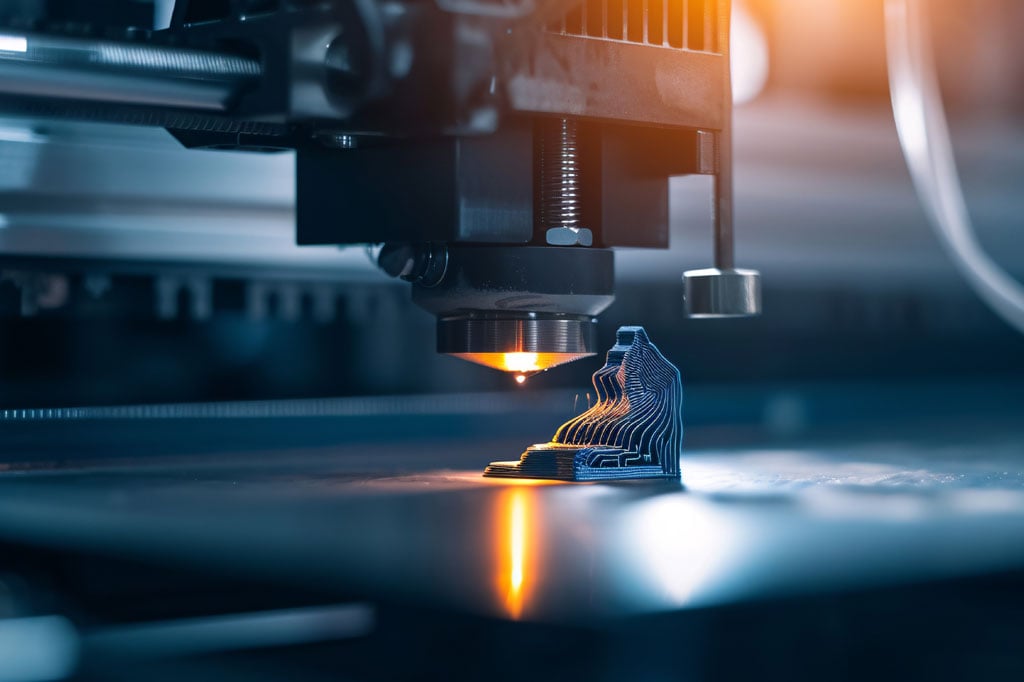Can you patent 3D printing innovations? The answer hinges on several factors. Intellectual property is pivotal in patenting 3D printing innovations, and the path to securing protection can be complex. This article elucidates the criteria that determines and qualifies a 3D printing inventions as patentable and provides a roadmap for navigating the application process. From understanding patent types to preparing a robust application, we equip you with essential insights to safeguard your 3D printing products and ensure your inventive efforts yield tangible legal protections.
Take, for example, Fortify, a Boston-based company specializing in 3D printing and photopolymer composites, collaborating with industry giants and defense organizations like Lockheed Martin and Raytheon. Whether you’re an independent inventor, entrepreneur, or part of a larger organization, comprehending patent law nuances is critical. This guide provides relevant insight on the intricacies of types of patents, outlines the essential criteria for patent eligibility, and offers step-by-step instructions to effectively file and defend your patent. By the end of this guide, you’ll possess the knowledge necessary to safeguard your groundbreaking 3D printing innovations.
What You’ll Learn
- Understanding Patentability: Discover how 3D printed products can qualify for patents based on their novelty, non-obviousness, and utility. Learn about the protections provided by utility patents for up to 20 years and design patents for 15 years.
- Ensuring Patentability: Explore the steps necessary to ensure the patentability of your 3D printing innovation. This includes meticulous design considerations, material selections, demonstrating practical utility by addressing real-world challenges, and understanding essential intellectual property rights.
- Navigating the Patent Process: Navigate the patent process specific to 3D printing innovations. This includes conducting thorough patent searches to assess novelty, filing both provisional and non-provisional patent applications, and maintaining your patent to preserve its enforceability over time.
Can You Patent 3D Printing Innovations? Understanding Patent Basics
Additive manufacturing, also termed 3D printing, stands as a pillar of innovation within the sphere of contemporary manufacturing. This technology encompasses a vast array of methods and tools, transforming the production process from initial prototypes to final goods. The methods and benefits of 3D printing include the ability to print complex geometries, rapid prototyping, and the efficient use of materials, which collectively revolutionize how items are created.
Different 3D printing technologies include Fused Deposition Modeling (FDM), Stereolithography (SLA), Selective Laser Sintering (SLS), and Digital Light Processing (DLP), each offering unique advantages for specific applications. The printers themselves range from desktop models suitable for hobbyists to industrial-grade machines capable of producing intricate and large-scale items.
Materials used in 3D printing are equally diverse, spanning from plastics and metals to ceramics and even biomaterials. These materials are selected based on the required properties of the final product, such as strength, flexibility, or biocompatibility.
The software powering 3D printing is another critical component, enabling precise control over the printing process. From Computer-Aided Design (CAD) programs that create detailed digital models to slicing software that prepares these models for printing, the digital tools involved are as crucial as the physical machinery.
With the capabilities that 3D printing offers, comes an increasing requirement for stringent intellectual property safeguards via patents to protect these technological achievements. Intellectual property protection is essential for safeguarding the technological advancements made in 3D printing.
What is Additive Manufacturing?
Employing advanced techniques in manufacturing, additive manufacturing or 3D printing constructs items precisely by adding material layer after layer according to detailed digital designs. This sophisticated production approach utilizes a diverse array of materials that range from various metals to biomaterials, each selected for their specific characteristics that contribute necessary qualities such as strength, flexibility, and in some cases even edibility to the completed product.
At its core, 3d printing excels at generating intricate and customized objects efficiently while also being more cost-effective compared with conventional production methods like injection molding. The implications extend far beyond mere prototyping. Notable industries including aerospace are now embracing 3D printing for the creation of final-use components—signifying a transformative shift within the realm of manufacturing practices. Protecting these innovations in additive manufacturing often involves navigating the complexities of intellectual property law.
Types of Patents for 3D Innovations
The U.S. Patent and Trademark Office (USPTO) acknowledges a variety of patent categories to protect 3D innovations.
- Utility Patents: Utility patents secure the technical and functional aspects of inventions, including new processes utilized in additive manufacturing.
- Design Patents: Design patents protect the distinctive aesthetic features of products created through 3D printing, ensuring exclusivity in their visual appearance.
- Plant Patents: New varieties of plants reproduced asexually can be safeguarded with plant patents, offering protection to innovators in agricultural applications.
Understanding the intricacies of the patent application process is essential for effectively securing these various types of patents for 3D innovations, ensuring comprehensive protection for your business.
The Patentability of 3D Printed Creations
Understanding the terrain of patent law requires a firm grasp on essential concepts. A product manufactured through 3D printing qualifies for a patent only if it is original, not immediately apparent to professionals in the field, and serves a practical purpose. The novelty of your invention is a critical factor; it must introduce something new that hasn’t been disclosed in prior art. Additionally, your invention must demonstrate a non-obvious inventive step, meaning it should not be an evident improvement to someone skilled in the relevant field. Lastly, the invention must have a specific, substantial, and credible utility, proving its practical application and usefulness.
Considering these criteria, it is also important to understand how intellectual property rights play a role in the patentability of 3D printed creations.
Meeting the Non-Obviousness Criterion
The non-obviousness criterion ensures that your invention constitutes a substantial and innovative advancement, rather than a minor tweak to existing ideas. This standard protects the inventive strides you’ve made from being dismissed as trivial modifications by experts in relevant fields, thereby preserving patentability for genuinely novel creations. Intellectual property protection plays a critical role in safeguarding these significant and pioneering advancements.
Ensuring Usefulness in Your Invention
Do not overlook the practical value of an invention. The design you create for 3D printing should transcend its visual appeal, on paper, by offering a tangible advancement in technology, solving a problem, or presenting a solution within the real-world context. Improvements to existing technology are also patentable, provided they introduce significant enhancements. To ensure this is accomplished, it’s crucial to thoughtfully consider the material selection during your creation process. Additionally, understanding intellectual property law can help you protect the practical value of your invention.
Protecting Your 3D Printable Files with IP Rights
There are several methods to secure your 3D printed creations.
- Patent: Secure the design and practical features of your 3D printed items with a patent.
- The visual attributes of your objects may be defended with design patents.
- For guarding the operational elements of your items, consider utility patents.
- Copyright: Your Computer-Aided Design (CAD) files can be shielded through copyright protection.
Design Patents for Digital Models
Design patents ensure the unique aesthetic of your 3D models is safeguarded, offering exclusive rights for a duration of 15 years starting from the date they are issued. This protection covers the distinctive look of your invention, regardless of which method of 3D printing is employed to materialize it.
Obtaining a design patent involves submitting detailed illustrations or photographs of your 3D model to the U.S. Patent and Trademark Office (USPTO). These visual representations must clearly depict the unique aspects of your design that you wish to protect. Once granted, a design patent provides robust legal protection, enabling you to prevent others from making, using, or selling a product that looks substantially similar to your patented design.
It’s important to note that while design patents protect the ornamental features of your 3D models, they do not cover the functional aspects. For comprehensive protection, you might consider securing both design and utility patents. This dual approach ensures that both the aesthetic and functional elements of your invention are legally safeguarded, providing a stronger defense against potential infringement.
Additionally, design patents can enhance the marketability of your 3D printed products. A patented design can serve as a unique selling proposition, distinguishing your products from competitors and potentially allowing you to command higher prices. The exclusivity granted by a design patent can also be a valuable asset in negotiations with investors or partners, showcasing your commitment to protecting and commercializing your innovative designs. Intellectual property rights play a crucial role in safeguarding the unique aesthetic of 3D models, ensuring that your creative efforts are legally protected.
Utility Patents and Software
Utility patents serve as a crucial ally in protecting the functional components of your 3D models. They safeguard the software and algorithms that transform digital designs into physical entities, making certain that these vital aspects of your invention remain secure within the systems crafted by adept engineers. These patents are not limited to just the physical aspects of your invention; they also cover the innovative processes and methodologies that make your 3D printed creations possible.
By securing a utility patent, you ensure that your unique methods and technological advancements are legally protected, preventing others from replicating your hard work and ingenuity. Additionally, utility patents can provide a competitive edge in the market, as they establish your position as a leader in technological innovation. This protection can be crucial for attracting investors and partners who are looking for cutting-edge solutions and reliable intellectual property safeguards. Ultimately, utility patents play a pivotal role in maintaining the integrity and exclusivity of your 3D printing innovations, ensuring that your contributions to the field are recognized and protected. The patent application process is essential for securing the functional components of 3D models.
Step-by-Step Guide to Patenting Your 3D Printed Product
Navigating the complex process of patenting a 3D printed creation is achievable. The first step involves seeking advice from a patent lawyer, and the journey culminates in obtaining a patent to safeguard your inventive product.
These are the crucial actions you can undertake with reference to move forward in this endeavor. Understanding intellectual property law is essential for effectively navigating the patenting process.
Step 1: Conducting a Thorough Patent Search
Before starting the patent application process, it is crucial to conduct an exhaustive search for patents. This step verifies that your invention is truly unique and does not encroach on any existing patents, thereby smoothing the path toward obtaining a successful patent grant. The patent application process further ensures that the uniqueness of your invention is thoroughly verified.
Step 2: Preparing and Filing a Provisional Application
A provisional patent application:
- Establishes the groundwork for acquiring your patent
- Allows you a one-year period to refine your invention while maintaining an early submission date
- Despite its informal nature, it holds significant value as it paves the way for the subsequent non-provisional application.
Establishing the groundwork for acquiring a patent also involves understanding and securing your intellectual property rights.
Step 3: Transitioning to a Non-Provisional Patent Application
After concluding the provisional stage, moving on to a non-provincial patent application marks an important progression. This detailed phase of the application process cements your rights, offering two decades of protection for your 3D printed invention. Understanding the patent application process is crucial for cementing your rights for a 3D printed invention.
After the Patent Is Filed: What’s Next?
The patent process doesn’t conclude with the submission of a filing. Instead, it proceeds into a phase involving scrutiny, discussions, and possibly appeals. During this time, one must remain active and prompt in dealing with matters as your application advances through the procedural steps.
Understanding intellectual property law is crucial during this ongoing process after filing a patent.
Responding to Office Actions
Office actions, necessitating either written responses or modifications to claims, play an essential role in the patenting process. At times, challenging a decision through an appeal may be required. With a sound strategy in place, this becomes merely another phase on the path to obtaining your patent. Dealing with office actions is a critical part of the patent application process.
Maintaining Your Patent
Once your patent is issued, the work continues beyond the initial grant. Here are key steps to maintain and protect your patent’s value:
Regular Monitoring: Begin by regularly monitoring your patent’s status and ensuring compliance with maintenance fees and deadlines set by the patent office.
Review and Evaluation: Periodically review the marketplace for potential infringements or violations of your patent rights. This involves staying informed about industry developments and competitors’ activities.
Documentation and Records: Maintain thorough documentation of any instances of patent infringement or challenges to your patent’s validity. Keep detailed records of all correspondence and legal actions related to your patent.
Strategic Adjustments: Based on your monitoring and review, make strategic adjustments to your patent strategy as necessary. This may involve updating claims, pursuing licensing opportunities, or taking legal action against infringers.
Timeline
Immediately after issuance: Ensure all maintenance fees and post-issuance filings are promptly submitted.
Quarterly monitoring: Regularly review market developments and competitor activities.
Annually: Conduct a comprehensive review of your patent portfolio and update strategies.
As needed: Respond to infringement notices or challenges to patent validity promptly.
By diligently following these steps and timelines, you can effectively maintain the robustness and value of your patent, ensuring long-term protection and potential commercial success.
Leveraging Patents for Business Advantage
Patents transcend their role as legal necessities; they are indispensable business tools. Beyond mere protection, patents confer significant competitive advantages, attract investors, and underscore an organization’s commitment to pioneering development. By strategically leveraging patents, businesses not only shield their intellectual property but also create avenues for monetization and market differentiation.
Utilizing patents effectively ensures that innovations are safeguarded against infringement, enabling businesses to capitalize on their unique offerings without fear of intellectual property theft. This proactive approach not only secures proprietary technologies but also strengthens market positioning, fostering long-term growth and sustainability in a competitive landscape.
Patent as a Tool for Competitive Edge
By building a strong patent portfolio, you effectively construct a barrier that deters competitors from encroaching on your business domain. This strategic defense not only asserts your market leadership, but also helps to reduce expenses.
Additionally, intellectual property protection serves as a crucial barrier against competitors, safeguarding your innovations and market position.
Attracting Investment with Patented Technology
Investors want to see that your innovations are proprietary and can not be replicated by a competitors before investing substantial capital in any endeavor. A strong patent application can provide assurance to investors that you innovations are novel and that you have taken the proper steps to ensure you have built a “barrier to entry” from replication. The competitors Lockheed Martin and Raytheon have invested $12.5 million in the 3D printing firm Fortify, which focuses on using composite materials to create intricate shapes for various applications including radar missile guidance, fighter jets, UAVs, and hypersonic technology. When your business invests in patents and intellectual property protections, it conveys a clear message to prospective investor’s that your serious about protecting your innovations and have taken the steps necessary to position your business as a leader in the marketplace.
Strategic Overview
Acquiring patents for your innovations in 3D printing is a tactical decision that can safeguard your inventions and strengthen your enterprise. This detailed guide has equipped you with the necessary insights and tools to proficiently maneuver through the patent process.
Strategic Asset: Beyond merely protecting your intellectual property, patents serve as a vital strategic asset in the competitive landscape of 3D printing. They can enhance your market position, providing a unique selling proposition that sets your products apart from those of your competitors. With a robust patent portfolio, you can deter potential infringers and establish a strong legal footing to defend your innovations.
Leveraging Patents: Moreover, patents can be leveraged to attract investments and partnerships. Investors are often more inclined to support businesses with patented technologies, viewing them as lower-risk and higher-potential ventures. This can lead to increased funding opportunities and the potential for collaborative projects that can drive further innovation and growth.
Licensing Agreements: Patents can also open up new revenue streams through licensing agreements. By licensing your patented technologies to other companies, you can generate passive income while expanding the reach and impact of your innovations. This not only maximizes the return on your investment in R&D but also fosters industry-wide advancements by enabling others to build upon your patented work.
Ultimately, the strategic use of patents in the realm of 3D printing can significantly bolster your business’s long-term success, ensuring that your innovative efforts are recognized, protected, and monetized effectively. Intellectual property protection is crucial for safeguarding inventions and strengthening enterprises.
Frequently Asked Questions
What is a provisional patent application?
A provisional patent application serves as a “placeholder” application for up to 12 months until a non-provisional patent application can be filed. The advantage of a provisional patent application is that it allows you to secure a filing date and enables you to refine and finalize your innovation before converting your provisional patent application to a non-provisional patent application.
What is the purpose of conducting a patent search?
Conducting a patent search is essential to check for existing prior art, ensuring the novelty of an invention against all references available in the public domain.
What are the different types of patents available?
There are three types of patent protection available: utility patents, design patents, and plant patents. These encompass the varied types of protection offered for inventions.
What is the importance of maintaining confidentiality before filing a patent?
Remember once you disclose your invention is the public domain you have 12 months to file a patent application or your invention is “time barred” and no longer patentable so confidentiality of your innovations is of the utmost importance.
What are the five important reasons to consider filing for a patent?
Protecting your proprietary innovations with a patent is of utmost importance as it enhances financial gains, increases the value of a corporation, creates barriers against competitors, and may help you attract investors.




